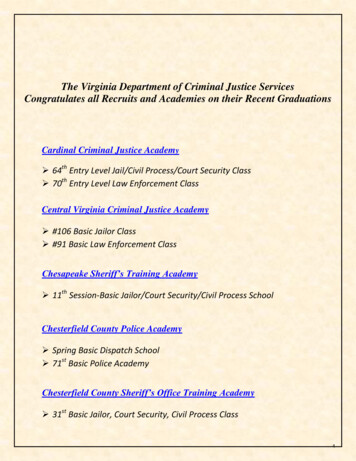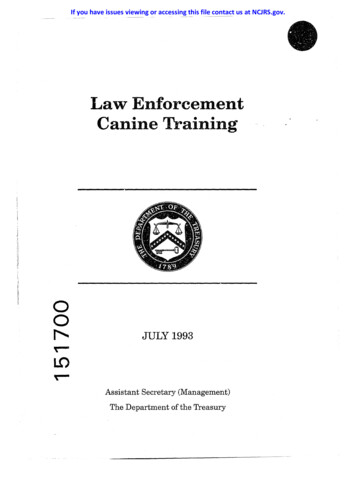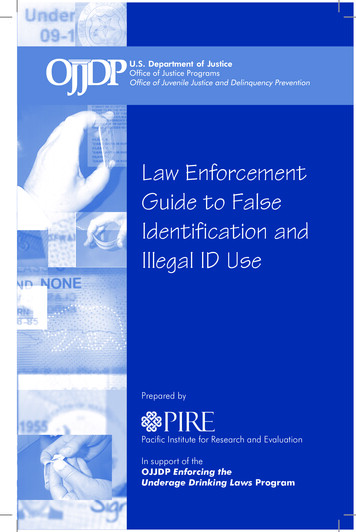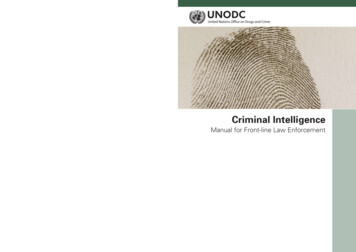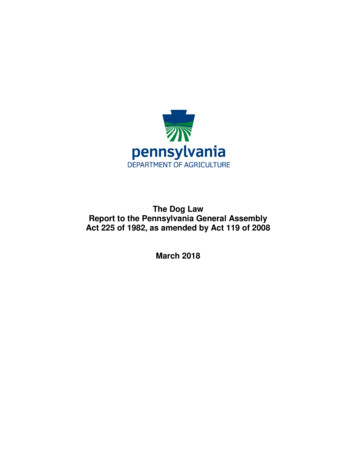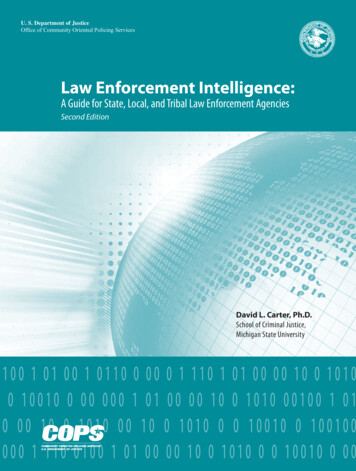
Transcription
U. S. Department of JusticeOffice of Community Oriented Policing ServicesLaw Enforcement Intelligence:A Guide for State, Local, and Tribal Law Enforcement AgenciesSecond EditionDavid L. Carter, Ph.D.School of Criminal Justice,Michigan State University
Law Enforcement Intelligence:A Guide for State, Local, and Tribal Law Enforcement AgenciesSecond EditionDavid L. Carter, Ph.D.School of Criminal Justice,Michigan State UniversityThis project was supported by Cooperative Agreement #2007-CK-WX-K015 by the U.S.Department of Justice Office of Community Oriented Policing Services. Points of view oropinions contained in this publication are those of the author and do not necessarily representthe official position or policies of the U.S. Department of Justice or Michigan State University.References to specific agencies, companies, products, or services should not be consideredan endorsement by the author or the U.S. Department of Justice. Rather, the references areillustrations to supplement discussion of the issues.
Letter from the COPS OfficeJanuary 2009Dear Colleague:This second edition of Law Enforcement Intelligence: A Guide for State, Local, andTribal Law Enforcement captures the vast changes that have occurred in the 4 yearssince the first edition of the guide was published in 2004 after the watershedevents of September 11, 2001.At that time, there was no Department of Homeland Security, Office of theDirector of National Intelligence, Information-Sharing Environment, or FusionCenters. Since the advent of these new agencies to help fight the war on terror,emphasis has been placed on cooperation and on sharing information amonglocal, state, tribal, and federal agencies. The successes of community policing areevident, not just within law enforcement, but also through agencies’ work with thecommunity to protect civil liberties and civil rights. A strong foundation betweenthe police and the community also yields valuable information for fightingcrime and terrorist threats. Through community policing and the wide array ofapproaches that fall under its umbrella—hot spots, CompStat, problem-orientedpolicing, and Intelligence-Led Policing—law enforcement can gather and shareinformation that will enhance public safety.Years of partnership building and problem solving with the community, theprivate sector, nonprofit organizations, elected officials, social service providers,and other key stakeholders have created an environment in which IntelligenceLed Policing and information sharing is more viable because of the strongrelationships established through community policing.This Guide serves as a road map to understanding criminal intelligence and itsrelated methodology, standards, processes, management, and resources. In fact,nearly 85 percent of the material in this second edition is new. I am proud to addthis valuable publication to the COPS Office library. My thanks to Dr. David Carterfor synthesizing the vast body of law enforcement information and intelligenceinto one volume that I know will be an indispensable knowledge resource forlaw enforcement agencies around the country. During these challenging times,community policing is more important than ever.Sincerely,Carl PeedFormer DirectorOffice of Community Oriented Policing ServicesLetter from the COPS Officev
PrefaceWhen the first edition of Law Enforcement Intelligence was published, itdocumented unprecedented changes in law enforcement intelligence thatoccurred largely in response to the September 11, 2001 terrorists’ attacks.Indeed, the new initiatives reflected philosophical and operational changesthat represented a geometric evolution in law enforcement intelligence in only3 short years. The first edition of the Guide described a broad array of cuttingedge issues and practices. At the time, it seemed implausible that such dramaticchanges would occur again. Nevertheless, since the publication of the first edition,a staggering number of significant developments affecting law enforcementintelligence have occurred: There were only a few Regional Intelligence Centers across the U.S. that arenow evolving into a nationwide network of fusion centers. The Fusion Center Guidelines had not been written. There had been no national fusion center conferences and regional fusioncenter groups did not exist. The Fusion Process Technical Assistance Program, a joint Department ofJustice and Department of Homeland Security project, did not exist. The Office of the Director of National Intelligence (ODNI) did not exist. The Information Sharing Environment did not exist. The FBI’s Intelligence Directorate did not exist. The DEA’s National Security Branch of the Office of Intelligence did not exist. The National Criminal Intelligence Resource Center did not exist. Many intelligence training programs that are now taken for granted did notexist. The Joint Regional Information Exchange System—which is now virtuallygone— was “the system” for information sharing and analysis. “All-hazards” intelligence was not in our lexicon. Intelligence-Led Policing was in its infancy. What is now the expansive Open Source Center which, as part of the ODNIis aggressively reaching out to state, local, and tribal law enforcement was anarrowly focused program called the Foreign Broadcast Information Serviceoperated by the CIA. Relatively few law enforcement agencies had any type of intelligencecapacity. Suspicious Activity Reporting (SAR) was largely limited to “tips and leads”and there were no unified standards or formal processes to report suspiciousactivities.This second edition of Law Enforcement Intelligence describes these and manymore changes in the philosophy, national standards, and practice of lawenforcement intelligence while maintaining the core goal of being a primer on “allthings intelligence” for the law enforcement community.Prefacevii
The Guide is intended to support policy in law enforcement agencies and seeksto objectively provide the best knowledge and practice of law enforcementintelligence at the time of publication. It is not meant as an academic work nordoes it look at theoretical issues or arguments. It is not directed as a guide tothe intelligence community except to explain the roles, responsibilities, andrestrictions of the intelligence community’s state, local, and tribal law enforcementpartners.The Internet references cited in this publication were valid as of June 2009. Giventhat URLs and web sites are in constant flux, neither the author nor the Office ofCommunity Oriented Policing Services can vouch for their current validity. Please notethat some of the sites referenced require a user name and/or password to gain access.viiiLaw Enforcement Intelligence: A Guide for State, Local, and Tribal Law Enforcement Agencies
AcknowledgmentsIn completing this second edition, first and foremost I want to thank Carl Peed,former Director of the Office of Community Oriented Policing Services (the COPSOffice). Carl’s support for both editions of Law Enforcement Intelligence wasconsistent, strong, and unwavering. Carl, I sincerely appreciate all you have donefor this project.I also thank the membership of the Criminal Intelligence Coordinating Council fortaking the time to review the original draft of this Guide to ensure that it reflectedthe information needed by the law enforcement intelligence community. Manypeople assisted me in the preparation of this Guide. Their contributions, large andsmall, helped in developing the comprehensive contents. While I hope to notleave out anyone, I particularly want to thank: Bill Harris (Delaware InformationAnalysis Center), Bob Hipple (Indianapolis [Indiana] Metropolitan PoliceDepartment), Bruce Parker (Brevard County [Florida] Sheriff’s Office, Retired), EdMcGarrell, Steve Chermak, Natalie Hipple, and Jeremy Carter (Michigan StateUniversity [MSU]), Hal Wilson (Drug Enforcement Administration), Kathy Suey(Las Vegas Metropolitan Police Department), Kelly Stone (North Central TexasFusion Center), Lance Ladines (Washington Joint Analysis Center), Mark Johnson(Open Source Center), Merle Manzi (Florida Department of Law Enforcement,Retired), Norm Beasley (Maricopa County [Arizona] Sheriff’s Office), Ray Guidetti(New Jersey Regional Intelligence Operations Center), Rick Stephens (FBI), RitchieMartinez (Arizona High Intensity Drug Trafficking Area), Roger Bragdon (Chief,Spokane [Washington] Police Department, Retired), Sabra Horne and Craig Manly(Office of the Director of National Intelligence), Scott Whitney (Customs andBorder Protection), and Tom Martinelli (Wayne State University).I expressly want to thank those who volunteered to review the Guide: Dan Oates(Aurora [Colorado] Police Department), Bob Casey (FBI), Ed McCarroll (Departmentof Homeland Security [DHS]), Kevin Saupp (DHS), Lisa Palmieri (DHS andInternational Association of Law Enforcement Intelligence Analysts), Mark Gage(National White Collar Crime Center) and Michael Ronczkowski (Miami-Dade PoliceDepartment). I know you were all a little surprised when you discovered the sizeof the document.I also had assistance from friends whose work went well beyond “a little help,”particularly reading and reviewing drafts. I thank Russ Porter (Iowa Department ofPublic Safety) for not only his review but also for giving me ideas and perspectiveson many issues. Larry Shaw (Florida Department of Law Enforcement) for helpingme navigate through the maze of information systems and networks. I sincerelyappreciate the extra time and work of Doug Bodrero and Phil Ramer (both of theInstitute for Intergovernmental Research) for giving me ideas, reviewing materials,and providing me with comprehensive comments while they were traversing thecountry on various projects, all for the promise of a meal and a drink.To Amy Schapiro, COPS Office Social Science Analyst: your constant support andfacilitation to make the processes go smoothly are appreciated. To Josh Reinschof the Michigan State University Intelligence Program, I thank you for your quickAcknowledgmentsix
work and willingness to make the extra effort in all that you do for us. And toRobyn Nielsen, also of the MSU Intelligence Program, I truly appreciate your hardwork, quick responses, unquestioned dedication, and support for this and otherprojects. You make my life a lot easier.To my longtime friend and coconspirator Andi Bannister (Wichita State University):I cannot thank you enough for meticulously reviewing every word of thisdocument and providing suggestions for content, wording, and presentation. Asalways, you made my work go much smoother (with fewer mistakes!) with all ofthe time and effort you put into reviewing this Guide.Also important, I thank my wife Karen, children Hilary, Jeremy, and Lauren andson-in-law Joseph O’Donnell who put up with the time I worked on this and otherprojects—you are always in my thoughts.Last, I dedicate this Intelligence Guide to a beautiful, smart, sweet, bundle of energywho always makes me smile: my granddaughter, Shey Catherine O’Donnell.David L. Carter, Ph.D.Michigan State UniversityxLaw Enforcement Intelligence: A Guide for State, Local, and Tribal Law Enforcement Agencies
Executive SummaryLaw Enforcement Intelligence: A Guide for State, Local, and Tribal Law EnforcementAgencies is a policy oriented review of current initiatives, national standards, andbest practices.The first two chapters provide definitions and context for the current state oflaw enforcement intelligence. Chapter 2 also provides a discussion of homelandsecurity—or “all-hazards”—intelligence. While more law enforcement agenciesand fusion centers are embracing the all-hazards approach, its application remainssomewhat unclear. This discussion provides a framework for homeland securityintelligence policy.Chapter 3 is a historical perspective that has multiple purposes. First, it provides adiscussion of past abuses by law enforcement intelligence because it is importantto understand the problems of the past in order to prevent them in the future.Next, the chapter provides a framework for national recommendations andprofessional standards for the practice of intelligence. Finally, the discussionidentifies the various working groups and committees that are framing the currentintelligence model and the relationship of those groups to federal agencies andprofessional law enforcement organizations.Fundamental to all types of intelligence is a system for managing the flow ofinformation for analysis. This is alternately called the Intelligence Process or theIntelligence Cycle. Chapter 4 is a descriptive discussion of the process as it appliesto law enforcement agencies. While there are different models for the IntelligenceProcess, this discussion relies on the model used in the National CriminalIntelligence Sharing Plan.Recommendations from both the National Criminal Intelligence Sharing Plan andthe COPS Office-funded International Association of Chiefs of Police intelligencesummits urge law enforcement agencies to adopt Intelligence-Led Policing (ILP).The challenge, however, is that there is no universally accepted definition orprocess for understanding and implementing ILP. Chapters 5 and 6 amalgamatethe diverse literature on ILP to provide a holistic view. Chapter 5 focuses on theconcept of ILP as it applies to American law enforcement, with a perspective onthe British approach from which the concept originated. Chapter 6 focuses on theorganizational and administrative processes for implementing ILP.There is no issue more topical (or controversial) in law enforcement intelligencethan the protection of civil rights and privacy. Chapter 7 is a broad examinationof the issue identifying the concerns expressed by citizens and illustrating someof the problems faced with intelligence operations through the use of two federalcivil rights cases. Integrated into the chapter is a detailed discussion of 28 CFRPart 23 and its application for placing information that identifies individuals ororganizations in a criminal intelligence records system. The discussion expandsthe issues further with a detailed discussion of intelligence records and civil rightsliability. The chapter ends with a discussion of how a law enforcement agency canimmunize itself against civil rights lawsuits related to the intelligence function.Executive Summaryxi
As a mechanism to enhance widespread information sharing among state,local, and tribal law enforcement agencies, the intelligence fusion concept grewrapidly. This growth was further spurred when fusion centers were embraced bythe Information Sharing Environment (ISE) to be the critical information-sharingclearinghouse for terrorism information between law enforcement and otherISE information-sharing partners. Chapter 8 describes the fusion concept andthe processes by which a fusion center operates. This chapter also addresses theconcerns that critics have expressed about fusion centers.Every major national standard for intelligence—the National Criminal IntelligenceSharing Plan, the Fusion Center Guidelines, the Information Sharing EnvironmentImplementation Plan and the Department of Homeland Security’s TargetCapabilities List—has recommended establishing a public-private partnershipfor information sharing to support the intelligence function. Few, however, haveestablished a substantive information-sharing relationship with the private sector.There are difficult hurdles to establishing such a relationship but it certainly ispossible. Chapter 9 discusses the recommendations, the issues, and the processesfor making public-private partnerships for intelligence a reality.At the heart of all intelligence activities is the need to manage a wide arrayof information. A number of critical issues in this process are important tounderstand. Chapter 10 addresses these issues in a comprehensive manner,relying on best practices and national standards. In a logically organizedapproach, the key topics discussed are: Suspicious Activity Reporting (SAR);defining and using intelligence requirements; the information collection processincluding the development of a collection plan; the role of analysis (from aconsumer’s perspective); and intelligence outputs and products. With the increaseof different information-sharing initiatives, one of the challenges has been toensure that the right information gets in the hands of the right people who canuse the information to develop policy and operational responses. This chapterincludes a discussion of information-sharing practices to avoid.A new initiative of the Office of the Director of National Intelligence is the NationalOpen Source Enterprise. The goal of open source information and intelligence isto exploit open sources as “the source of first resort” in any intelligence endeavor.The reasons are that open sources are easier, faster, pose less risk to civil rights,and are less controversial for the agency. Part of this new initiative is to includelaw enforcement intelligence in open source information sharing. Chapter 11provides a detailed discussion of open sources, the different types of informationthat can be obtained, how it can be obtained, and caveats for analysis.A wide—and confusing—array of federal intelligence resources, includingnetworks, systems, analytic services, applications and products, is available tostate, local, and tribal law enforcement. Many have a specialized expertise ora limited area of application, while others are very broad in their application.Chapter 12 discusses federal intelligence resources, starting with a discussionof classified information, including a description of the process for a state, local,or tribal law enforcement officer to obtain a federal security clearance. MostxiiLaw Enforcement Intelligence: A Guide for State, Local, and Tribal Law Enforcement Agencies
law enforcement officers, however, will not have a clearance and will be dealingwith Sensitive But Unclassified (SBU) information. A discussion is providedof the meaning and rules for SBU information sharing. Important to note:SBU information is going through a government-wide transition to becomecategorized as Controlled Unclassified Information (CUI) and has some distinctissues for sharing and storing the information. The chapter provides a detaileddiscussion of CUI and the guidelines imposed for its use. The last part of thechapter is an encyclopedic listing of diverse federal information and intelligencesystems and resources.One of the recommendations of the National Criminal Intelligence Sharing Planis that every law enforcement agency, regardless of size, should develop anintelligence capacity. For some agencies this will be an entire unit, while for otheragencies it will be a part-time assignment of one person. In either case, there aremanagement concerns related to the intelligence function. Chapter 13 focuses onmanagement concerns that have relative uniqueness to the intelligence function.It begins with a comprehensive list of factors to consider when developing theintelligence capacity. This is followed by a detailed description of developing aConcept of Operations (ConOps) that serves as the road map for developing andimplementing the intelligence function. Finally, a wide range of managementissues are discussed, ranging from developing policies to human resourcesconcerns.The final chapter examines critical issues and challenges for the future anda model for implementing change. The Guide also includes comprehensiveresources for all aspects of intelligence, a glossary of intelligence terms, andappendixes to support the various discussions. Included in the appendixes aretwo intelligence audit checklists.Executive Summaryxiii
ContentsChapter 1:Letter from the COPS Office . . . . . . . . . . . . . . . . . . . . . . . . . . . . . . . . . . . . . . . . . . . . . . . . vPreface . . . . . . . . . . . . . . . . . . . . . . . . . . . . . . . . . . . . . . . . . . . . . . . . . . . . . . . . . . . . . . . . . . . . viiAcknowledgments . . . . . . . . . . . . . . . . . . . . . . . . . . . . . . . . . . . . . . . . . . . . . . . . . . . . . . . . ixExecutive Summary . . . . . . . . . . . . . . . . . . . . . . . . . . . . . . . . . . . . . . . . . . . . . . . . . . . . . . . . xiIntroduction 1Perspective . . . . . . . . . . . . . . . . . . . . . . . . . . . . . . . . . . . . . . . . . . . . . . . . . . . . . . . 5Conclusion . . . . . . . . . . . . . . . . . . . . . . . . . . . . . . . . . . . . . . . . . . . . . . . . . . . . . . . . . . . . 6Chapter 2:Understanding Contemporary Intelligence forLaw Enforcement Organizations: Concepts andDefinitions 7Defining Intelligence . . . . . . . . . . . . . . . . . . . . . . . . . . . . . . . . . . . . . . . . . . . . . . . . . . 10Law Enforcement Intelligence . . . . . . . . . . . . . . . . . . . . . . . . . . . . . . . . . . . . . 11Homeland Security (All-Hazards) Intelligence . . . . . . . . . . . . . . . . . . . . . . 14National Security Intelligence . . . . . . . . . . . . . . . . . . . . . . . . . . . . . . . . . . . . . 15Emerging Intelligence Initiatives Associated with Homeland Security/AllHazards Intelligence . . . . . . . . . . . . . . . . . . . . . . . . . . . . . . . . . . . . . . . . . . . . . . . . . 19Fire Service Intelligence Enterprise . . . . . . . . . . . . . . . . . . . . . . . . . . . . . . . . 19Medical Intelligence: Protecting the Public Health . . . . . . . . . . . . . . . . . 20Gang Intelligence . . . . . . . . . . . . . . . . . . . . . . . . . . . . . . . . . . . . . . . . . . . . . . . . . . . . . 21What Is a Gang? . . . . . . . . . . . . . . . . . . . . . . . . . . . . . . . . . . . . . . . . . . . . . . . . . . . 22National Gang Intelligence Center . . . . . . . . . . . . . . . . . . . . . . . . . . . . . . . . . 23Conclusion . . . . . . . . . . . . . . . . . . . . . . . . . . . . . . . . . . . . . . . . . . . . . . . . . . . . . . . . . . . . 24Chapter Annex 2-1: Law Enforcement and Homeland Security IntelligenceCase Study . . . . . . . . . . . . . . . . . . . . . . . . . . . . . . . . . . . . . . . . . . . . . . . . . . . . . . . . . 25Threats Posed by Zebra Mussels . . . . . . . . . . . . . . . . . . . . . . . . . . . . . . . . . . . 25Chapter 3:A Brief History of Law Enforcement Intelligence:Past Practice and Recommendations for Change 29Law Enforcement Intelligence: The Years of Evolution . . . . . . . . . . . . . . 31Congressional Inquiries into Intelligence Activities . . . . . . . . . . . . . . . . . 34National Crime Commissions and New Initiatives Influencing the Evolutionof State, Local, and Tribal Law Enforcement Intelligence . . . . . . . . . . . . . . 36The Commissions and their Purpose . . . . . . . . . . . . . . . . . . . . . . . . . . . . . . . 36The National Crime Commissions and Law Enforcement Intelligence38Law Enforcement Intelligence Initiatives in the Post-9/11 Environment . . 43Collateral Developments . . . . . . . . . . . . . . . . . . . . . . . . . . . . . . . . . . . . . . . . . . 49Implications . . . . . . . . . . . . . . . . . . . . . . . . . . . . . . . . . . . . . . . . . . . . . . . . . . . . . . 51Law Enforcement Intelligence at the State, Local, and Tribal Levels . . . . . . 52Conclusion . . . . . . . . . . . . . . . . . . . . . . . . . . . . . . . . . . . . . . . . . . . . . . . . . . . . . . . . . . . . 53Contentsxv
Chapter 4:The Intelligence Process (Cycle) for State, Local,and Tribal Law Enforcement . . . . . . . . . . . . . . . . . . . . . . . . 55Planning and Direction . . . . . . . . . . . . . . . . . . . . . . . . . . . . . . . . . . . . . . . . . . . . 59Collection . . . . . . . . . . . . . . . . . . . . . . . . . . . . . . . . . . . . . . . . . . . . . . . . . . . . . . . . . 62Processing/Collation . . . . . . . . . . . . . . . . . . . . . . . . . . . . . . . . . . . . . . . . . . . . . . 64Analysis . . . . . . . . . . . . . . . . . . . . . . . . . . . . . . . . . . . . . . . . . . . . . . . . . . . . . . . . . . . 68Dissemination . . . . . . . . . . . . . . . . . . . . . . . . . . . . . . . . . . . . . . . . . . . . . . . . . . . . 69Reevaluation . . . . . . . . . . . . . . . . . . . . . . . . . . . . . . . . . . . . . . . . . . . . . . . . . . . . . . 73Conclusion . . . . . . . . . . . . . . . . . . . . . . . . . . . . . . . . . . . . . . . . . . . . . . . . . . . . . . . . . . . . 73Chapter Annex 4-1: Federal Bureau of Investigation Intelligence Cycle . . . 74The FBI Intelligence Cycle . . . . . . . . . . . . . . . . . . . . . . . . . . . . . . . . . . . . . . . . . 74Chapter 5:The Concept of Intelligence-Led Policing (ILP) . . . . . . . 77Conceptual Foundations . . . . . . . . . . . . . . . . . . . . . . . . . . . . . . . . . . . . . . . . . . 79Defining ILP . . . . . . . . . . . . . . . . . . . . . . . . . . . . . . . . . . . . . . . . . . . . . . . . . . . . . . . 80Fundamental Perspectives on the History of ILP: The British Experience . 82Perspective 1: The Current State of American Law Enforcement Intelligence82Perspective 2: The British National Intelligence Model and Challenges inAdapting It to U.S. Law Enforcement . . . . . . . . . . . . . . . . . . . . . . . . . . . . . 84Comparing U.S. and U.K. Law Enforcement Intelligence . . . . . . . . . . . . . 86ILP And Community Policing, Problem Solving, and CompStat . . . . . . . . . . 86Comparing ILP and CompStat . . . . . . . . . . . . . . . . . . . . . . . . . . . . . . . . . . . . . 88Ethical Issues . . . . . . . . . . . . . . . . . . . . . . . . . . . . . . . . . . . . . . . . . . . . . . . . . . . . . . 91Civil Rights and ILP . . . . . . . . . . . . . . . . . . . . . . . . . . . . . . . . . . . . . . . . . . . . . . . . 91Public Education . . . . . . . . . . . . . . . . . . . . . . . . . . . . . . . . . . . . . . . . . . . . . . . . . . 92Community Members as Law Enforcement Volunteers . . . . . . . . . . . . . 93Chapter 6:Developing and Implementing Intelligence-LedPolicing . . . . . . . . . . . . . . . . . . . . . . . . . . . . . . . . . . . . . . . . . . . 97Establishing a Framework for Strategic Priorities and Information Processing: TheInformation Management Plan . . . . . . . . . . . . . . . . . . . . . . . . . . . . . . . . . . . . . . 100The Information Management Plan . . . . . . . . . . . . . . . . . . . . . . . . . . . . . . . . . . . . 102Establishing Strategic Priorities forIntelligence-Led Policing . . . . . . . . . . . . . . . . . . . . . . . . . . . . . . . . . . . . . . . . 102Intelligence Requirements . . . . . . . . . . . . . . . . . . . . . . . . . . . . . . . . . . . . . . . . . 107Collection Plan . . . . . . . . . . . . . . . . . . . . . . . . . . . . . . . . . . . . . . . . . . . . . . . . . . . . 107Analysis . . . . . . . . . . . . . . . . . . . . . . . . . . . . . . . . . . . . . . . . . . . . . . . . . . . . . . . . . . . 108Intelligence Products . . . . . . . . . . . . . . . . . . . . . . . . . . . . . . . . . . . . . . . . . . . . . . 108Operational Responses . . . . . . . . . . . . . . . . . . . . . . . . . . . . . . . . . . . . . . . . . . . . 109Review of the Process . . . . . . . . . . . . . . . . . . . . . . . . . . . . . . . . . . . . . . . . . . . . . 109Summary . . . . . . . . . . . . . . . . . . . . . . . . . . . . . . . . . . . . . . . . . . . . . . . . . . . . . . . . . 110Organizational Infrastructure for ILP . . . . . . . . . . . . . . . . . . . . . . . . . . . . . . . . . . . 110Commitment . . . . . . . . . . . . . . . . . . . . . . . . . . . . . . . . . . . . . . . . . . . . . . . . . . . . . 111xviLaw Enforcement Intelligence: A Guide for State, Local, and Tribal Law Enforcement Agencies
Partnerships . . . . . . . . . . . . . . . . . . . . . . . . . . . . . . . . . . . . . . . . . . . . . . . . . . . . . . 112Information-Sharing Processes . . . . . . . . . . . . . . . . . . . . . . . . . . . . . . . . . . . . 117Operational Plan . . . . . . . . . . . . . . . . . . . . . . . . . . . . . . . . . . . . . . . . . . . . . . . . . . 118Analytic Capability . . . . . . . . . . . . . . . . . . . . . . . . . . . . . . . . . . . . . . . . . . . . . . . . 118Tactical and Strategic Response Alternatives . . . . . . . . . . . . . . . . . . . . . . . 119Next Steps: Implementation . . . . . . . . . . . . . . . . . . . . . . . . . . . . . . . . . . . . . . . . . . . 120The Implementation Starting Point . . . . . . . . . . . . . . . . . . . . . . . . . . . . . . . . 122Conclusion . . . . . . . . . . . . . . . . . . . . . . . . . . . . . . . . . . . . . . . . . . . . . . . . . . . . . . . . . . . . 125Chapter Annex 6-1:Community Education Handout . . . . . . . . . . . . . . . . . . . . . . . . . . . . . . . . . . . . . 128Wichita State UniversityRegional Community Policing Institute . . . . . . . . . . . . . . . . . . . . . . . . . . 128Chapter 7:Civil Rights and Privacy in the Law EnforcementIntelligence Process 129Privacy and Civil Rights: A Foundation . . . . . . . . . . . . . . . . . . . . . . . . . . . . . 133Increased Scrutiny of Law Enforcement Intelligence: The Challenge ofBalancing Civil Liberties and Community Safety . . . . . . . . . . . . . . . . . . . . . . 134Lawsuits and Decrees Related to Law Enforcement IntelligenceActivities . . . . . . . . . . . . . . . . . . . . . . . . . . . . . . . . . . . . . . . . . . . . . . . . . . . . . . . 137Civil Rights Example: First Amendment Free Expression—Two Views143The Need for More Controls of Intelligence Inquiries than CriminalInvestigations40 . . . . . . . . . . . . . . . . . . . . . . . . . . . . . . . . . . . . . . . . . . . . . . . . 145Maintaining Privacy in the Intelligence Process . . . . . . . . . . . . . . . . . . . . . . . . . 14628 CFR Part 23 – Criminal Intelligence Operatin
viii. Law Enforcement Intelligence: A Guide for State, Local, and Tribal Law Enforcement Agencies The . Guide is intended to support policy in law enforcement agencies and seeks to objectively provide the best knowledge and practice of law enforcement

